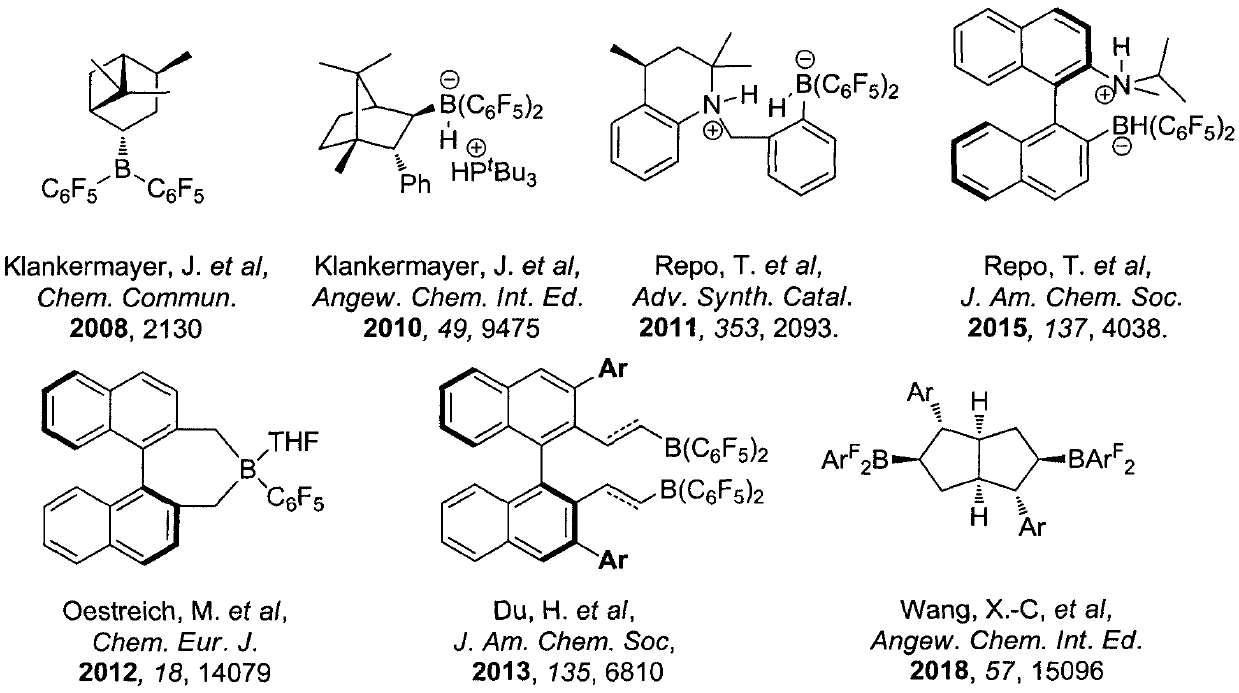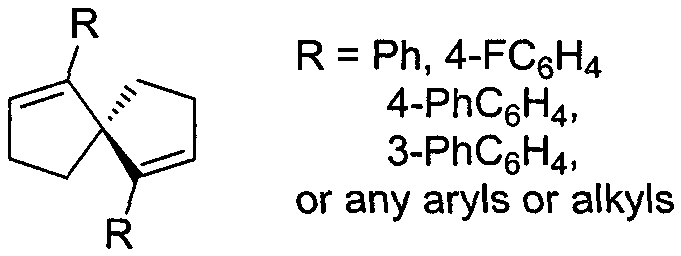Synthesis of spiro-ring bis-boron catalyst and application thereof in hydrogenation reaction
A catalyst and spiro ring technology, which is applied in the synthesis of spiro diene compounds, can solve the problems of limited chiral boron catalysts, and achieve the effects of solving heavy metal residues, high reactivity, and mild reaction conditions
- Summary
- Abstract
- Description
- Claims
- Application Information
AI Technical Summary
Problems solved by technology
Method used
Image
Examples
Embodiment 1
[0024] Example 1: Synthesis of Chiral Spirodiene 3a
[0025]
[0026] The first step: resolution of spiro[4.4]-1,6-nonanedione
[0027] (R)-Phenylethylaminooxalazide (4.15 g, 2 eq) was added to a dry 250 mL round bottom flask, followed by 1.52 g of racemic spiro[4.4]-1,6-nonanedione and a small pellet of iodine Simple substance, add 120mL of anhydrous dichloromethane under the protection of argon, install a water separator and reflux condenser, and heat to reflux overnight. After the reaction, the system was cooled to room temperature, and the insoluble solid was removed by diatomaceous earth filtration, and the dichloromethane was removed by rotary evaporation under reduced pressure to obtain a yellow solid crude product, which was recrystallized and purified from anhydrous ethanol to obtain 3.5 g of a white powdery solid dihydrazone compound intermediate , yield 66%.
[0028] 2.0 g of the spirodione dihydrazone compound intermediate was added to a 500 mL eggplant-shaped...
Embodiment 2
[0034] Example 2: Synthesis and identification of spirocyclic bis-boron catalyst 4a
[0035]
[0036] In the glove box, 3a (13.6mg, 0.05mmol), HB(C 6 f 5 ) 2 (34.6mg, 0.1mmol) and toluene (1.0mL), react at 25°C for 15 minutes. Isoquinoline (25.8mg, 0.2mmol) and toluene (0.5mL) were added again, and the reaction was continued at 25°C for 30 minutes. After the reaction was over, the toluene was distilled off under reduced pressure to obtain a white powdery solid, which was added with the internal standard CH 2 Br 2 ,pass 1 H NMR judged that the NMR yield was 95%. The crude product was recrystallized from dichloromethane and n-hexane to obtain product 4a·2L. 1 H NMR (400MHz, CD 2 Cl 2 )δ8.74(s, 2H), 8.04(d, J=6.8Hz, 2H), 7.83(t, J=7.5Hz, 2H), 7.74(d, J=8.1Hz, 2H), 7.62(t, J=7.4Hz, 2H), 7.59-7.30(m, 8H), 7.16(t, J=7.1Hz, 2H), 6.87(br, 2H), 6.69(br, 2H), 2.92(t, J=9.6 Hz, 2H), 2.32-2.18(m, 2H), 2.14(d, J=9.0Hz, 2H), 1.80-1.54(m, 4H), 0.86(dd, J=19.2, 11.5Hz, 2H); 13 ...
Embodiment 3
[0037] Example 3: Synthesis of (R)-2-Methyl-1,2,3,4-tetrahydroquinoline (P1)
[0038]
[0039] Spirochiral diene 3a (3.4mg, 0.0125mmol, 5mol%) and HB(C 6 f 5 ) 2 (8.65 mg, 0.025 mmol, 10 mol%) was added to a 10 mL small test tube, 2 mL of trifluorotoluene was added to dissolve, and the reaction was carried out at 25°C for 15 minutes. The system was cooled to room temperature, then 2-methylquinoline S1 (35.8mg, 0.25mmol) and 3mL benzotrifluoride were added, and then the test tube was transferred to the autoclave, after replacing the hydrogen three times, and finally filled with hydrogen to 50bar,- Reaction at 20°C for 24h. After the reaction, hydrogen was released, the solvent was removed by rotary evaporation, and the residue was separated and purified by silica gel column chromatography to obtain the hydrogenated product P1, a colorless oily liquid, with a yield of 97% and an enantioselectivity of 90% ee. 1 H NMR (400MHz, CDCl 3 )δ7.00-6.95 (m, 2H), 6.68-6.59 (m, 1H),...
PUM
 Login to View More
Login to View More Abstract
Description
Claims
Application Information
 Login to View More
Login to View More - R&D
- Intellectual Property
- Life Sciences
- Materials
- Tech Scout
- Unparalleled Data Quality
- Higher Quality Content
- 60% Fewer Hallucinations
Browse by: Latest US Patents, China's latest patents, Technical Efficacy Thesaurus, Application Domain, Technology Topic, Popular Technical Reports.
© 2025 PatSnap. All rights reserved.Legal|Privacy policy|Modern Slavery Act Transparency Statement|Sitemap|About US| Contact US: help@patsnap.com



